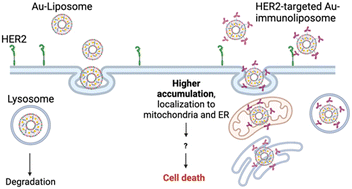Development of immunoliposomes containing cytotoxic gold payloads against HER2-positive breast cancers†‡
Abstract
Overexpression of the human epidermal growth factor receptor 2 (HER2) is found in 20–30% of breast cancer tumors (HER2-positive breast cancers) and is associated with more aggressive onset of disease, higher recurrence rate and increased mortality. Monoclonal antibodies (mAb) like trastuzumab and pertuzumab in combination with chemotherapeutics, and trastuzumab-based antibody drug conjugates (ADCs) are used in the clinic to treat these cancers. An alternative targeted strategy (not yet in clinical use) is the encapsulation of chemotherapeutic drugs in immunoliposomes. Such systems may not only facilitate targeted delivery to the tumor and improve intracellular penetration, but also override some of the resistance developed by tumors in response to cytotoxic loads. As a supplement to classical chemotherapeutics (based on organic compounds and conventional platinum-based derivatives), gold compounds are emerging as potential anticancer agents due to their high cytotoxicity and capacity for immunogenic cell death. Here, we describe the development of immunoliposomes functionalized with trastuzumab and pertuzumab; containing simple gold(I) neutral compounds ([AuCl(PR3)] (PR3 = PPh3 (1), PEt3 (2))) generated by the thin-film method to afford Lipo-1–Lipo-2. Trastuzumab and pertuzumab were engrafted onto these liposomes to generate gold-based immunoliposomes (Immunolipo-Tras-1, Immunolipo-Tras-2, Immunolipo-Per-1, Immunolipo-Per-2). We have characterized all liposomal formulations and demonstrated that the immunoliposomes (190 nm) are stable, have high binding affinity for HER2, and display selective cytotoxicity towards HER2-positive breast cancer cell lines. Trastuzumab-based immunoliposomes of a smaller size (100 nm) – encapsulating [AuCl(PEt3)] (2) – have been generated by an extrusion homogenization method. These optimized immunoliposomes (Opt-Immunolipo-Tras-2) have a trastuzumab engraftment efficiency, encapsulation efficiency for 2, and affinity for HER-2 similar to the immunoliposomes obtained by sonication (Immunolipo-Tras-2). While the amount of Au encapsulated is slightly lower, they display almost identical cytotoxicity and selectivity profiles. Moreover, the fluorescently-labeled phosphane drug [AuCl(PPh2-BODIPY)] (3) was encapsulated in both larger (Immunolipo-Tras-3) and smaller (Opt-Immunolipo-Tras-3) immunoliposomes and used to visualize the intracellular localization of the payload. Fluorescent imaging studies found that Opt-Immunolipo-Tras-3 accumulates in the cells more than 3 and that the unencapsulated payload accumulates primarily in lysosomes, while targeted liposomal 3 localizes in mitochondria and ER, hinting at different possibilities for modes of action.



 Please wait while we load your content...
Please wait while we load your content...